High-performing manufacturers has been saved

High-performing manufacturers Where they play and how they win
29 November 2016
When it comes to competitiveness, what differentiates the top global manufacturers from the rest? Learn the capabilities and attributes that help make top performers stand out—even when the bar continues to rise.
An in-depth study of high performance
No one has to tell manufacturing company executives that it’s getting tougher to differentiate themselves and compete successfully—they feel the pressure every day. Rapid globalization, technological advancements, changing consumer preferences, and evolving government policies are reshaping the manufacturing industry, exponentially accelerating the pace of competition and continually raising the bar on company performance.
Still, some manufacturers consistently and convincingly outperform their peers (see sidebar “Why study high-performing manufacturers?”). How are they doing this? And what can “the rest” learn from “the best” to improve their own performance? This report provides executives with clear direction on what companies need to do to be high-performing manufacturers—now and in the future. For more than 25 years, we’ve been studying manufacturers to identify what sets apart high-performing companies (defined in the section “About the study”) from their competitors. We found that high performers focus carefully on the development of specific but evolving sets of manufacturing capabilities to differentiate themselves and succeed in the marketplace. These capabilities, when coupled together, are difficult for their competitors to replicate, and when executed well, they create long-term competitive advantage by generating greater customer loyalty, higher market share, and superior profitability.
About the study
As part of Deloitte’s ongoing collaboration with the US Council on Competitiveness on the Global Competitiveness in Manufacturing Initiative, we conducted a global study of manufacturing CEOs in 2010, 2013, and 2016. Together, these three studies received a total of over 1,600 CEO responses.
On a broad list of capabilities, we asked CEOs to rate their companies’ current competitiveness in each capability relative to their closest global rivals, as well as rate how important they thought each capability would be to staying competitive in the future. In order to remove the variations in rating among countries (due to culture), industry subsectors, and company revenue sizes, we normalized the data by country, industry, and size, and calculated current and future index scores for each of the capabilities on a 10–100 scale for both current competitiveness and future importance.
We separated the respondents’ companies into “high performers” and “other companies” (all other companies studied). High performers were identified on the basis of four parameters: the company’s actual profitability, its profitability when compared to its peers, whether the company met or exceeded its profitability goals, and the company’s performance on return on assets.
This classification methodology for selecting high performers showed that 30 percent of the high performers were in the top 10 percent of profitability relative to their primary global industry competitors, and four-fifths (81 percent) of the high performers were in the top third. Among the other companies, only 1 percent were in the top 10 percent of profitability, and only 9 percent were in the top third, relative to their primary global industry competitors. In addition, 25 percent of the high performers were in the top 10 percent on return on assets (ROA) relative to their primary global industry competitors; 74 percent of the high performers had ROAs in the top third. Among the other companies, only 1 percent had ROAs in the top 10 percent and only 5 percent had ROAs in the top third relative to their primary global industry competitors.
To dig deeper into the attributes of high-performing manufacturers, Deloitte collaborated with the US Council on Competitiveness to conduct a global survey of over 500 manufacturing C-suite executives in 2016. This report, which draws on the survey’s results, builds on the 2010 and 2013 editions of this survey and further extends the story of manufacturing competitiveness in the 21st century.
Even for high performers, it isn’t easy to continually excel in the dynamic, hypercompetitive global manufacturing industry. However, this study provides an operating framework to help C-suite executives decide “where to play and how to win.” Becoming a high performer requires a keen focus on acquiring needed capabilities, which not only change with time but also vary based on where a company chooses to play: in which markets, with which customers and consumers, in which channels, and in which product categories and services the company wants to compete. To determine how to win, company leaders should consider which capabilities will enable the organization to create unique value and consistently deliver that value to customers in a way that is distinct from competitors’ offerings.
This year’s study suggests that high-performing manufacturers share several common attributes that distinguish them from the rest:
- Brand, reputation, and managing customer perceptions are the top priority among high-performing manufacturers to pursue current and future competitiveness.
- Talent remains a key capability among high performers, while the gap is closing on leadership capabilities.
- High performers are focused on improving their price competitiveness while setting their sights on new markets and new customers.
- High performers are aggressively applying new, advanced technologies to help drive innovation while protecting intellectual property with an enhanced emphasis on cybersecurity capabilities as key differentiators for future competitiveness.
Why study high-performing manufacturers?
High performers outpace, by a significant margin, other manufacturing companies in many dimensions of revenue performance. To understand the importance of being a high performer, Deloitte conducted an in-depth financial analysis of global manufacturing firms. We divided the top global manufacturing companies (the top 2,000 global manufacturing firms by FY 2014 sales) into top and bottom quartiles based on their average gross margin for the period 2004–2014, and compared the financial performance of the bottom quartile with the top in seven categories.
In all categories, manufacturing firms in the top quartile (the high performers) had much higher profitability or provided superior returns compared to firms in the bottom quartile (figure 1).

The differences between high performers and all other manufacturers in our study are striking. High performers are operating with such strength that their impact on the future of the manufacturing industry is likely to be substantial. Understanding which manufacturing capabilities high performers consider to be important to their current and future competitiveness can provide important lessons—and a potential strategic advantage—to all companies.
Why manufacturing matters: The role of manufacturing in the broader economy
From its influence on infrastructure development and job creation to its contribution to gross domestic product on both an overall and per-capita basis, a strong manufacturing sector creates a clear path toward economic prosperity. In 2015, manufacturing in the United States generated more jobs than any other sector, employing 12.3 million workers and supporting another 56.6 million (indirect and induced jobs).1 The sector also creates higher income jobs: A typical US manufacturing worker earned an average of $81,289 in 2015 compared to average earnings of $63,830 in other industries.2
A framework for analyzing high performers
To truly understand the strategies of high-performing manufacturers—or any company—you have to delve deep into how these organizations are developing competitive capabilities. Toward this end, we asked C-suite executives participating in this global study to rate their companies’ current competitiveness relative to their closest global rivals on each of 35 specific capabilities. We also asked these manufacturing executives to rate the future importance of those same capabilities. With this as our starting point, we converted their answers into a 100-point index scale from 10 to 100, while normalizing responses for company size and geography. This allowed us to compare the responses and strategies of high performers to those of all other manufacturers using a framework of three key elements:
- The positioning of clusters of capabilities along two dimensions is the first element of our framework. Those two dimensions are (a) how competitive an organization is today with regard to the capability and (b) how important the organization believes that capability is to their future competitiveness, which is a surrogate for how much emphasis they are placing on enhancing their competitiveness specific to that capability in the future. Figure 2 shows the two dimensions of this first element in our framework, with the horizontal axis (x-axis) representing how competitive a company is today specific to an individual capability, and the vertical axis (y-axis) representing how important it believes that capability is to its future competitiveness. Taking high performers as a group, we plotted their ratings of each capability along the two axes (figure 4) and then looked for logical groupings or clusters of capabilities (figure 5) to gain a clear picture of these high-performing companies’ strategies.
- The four classes of differentiating capabilities are the second element of our framework. While the positioning of individual capabilities as well as the clustering of capabilities reveal much about high performers’ strategies, they tell us nothing about whether those strategies are the same or different from the strategies of all other manufacturing organizations. To determine this, we analyzed each capability to determine if in fact there is a statistically significant difference between its position among high performers versus all other companies. Four distinct classes of capabilities emerged: (a) game changers, (b) creating advantage, (c) being challenged, and (d) qualifiers. Figure 3 defines the four classes and groups the 35 individual capabilities by class, while figure 4 shows the specific class for each capability among the high-performing companies in our sample, plotted along the dimensions of current competitiveness (x-axis) and future importance (y-axis). Game changers are capabilities where high performers are both more competitive today and place more importance on the capability for future competitiveness than their peers. This means that, relative to all other manufacturers, high performers place game changer capabilities further to the right and further toward the top along the two dimensions of competitiveness. Creating advantage capabilities are those where there is no real difference between high performers and other companies with regard to their current competitiveness, but on which high performers are placing a much higher degree of emphasis and importance for the future. Being challenged capabilities are those in which high performers hold a competitive advantage today, but on which high performers and other companies place a similar degree of importance for the future. Finally, qualifiers are capabilities where there is no statistically significant difference between high performers and all other companies in either their current competitiveness or the capability’s future importance. Statistically speaking, high performers and all other companies treat qualifier capabilities the same way; they are essentially table stakes for competing today and in the future.
- Shift indicators are the third element of our framework. Shift indicators are detected when a capability shows a statistically significant deviation from the diagonal (figure 6). Any capability plotted above the thick diagonal in figure 6 is considered to be more important to future competitiveness relative to companies’ current level of competitiveness in that capability; the farther above the diagonal a capability falls, the more important it is to high performers’ future competitiveness relative to their current competitiveness in that capability. Similarly, any capability plotted below the thick diagonal is anticipated to be less important in the future, relative to companies’ current competitiveness in that capability. When plotted for the group of high performers, shift indicator capabilities indicate areas where these high performers are focusing significantly more (or less) in the future—signifying a “shift” in their strategic focus (figure 7). (For capabilities contained within the thickness of the diagonal, we are not able to truly determine their level of future importance relative to current competitiveness, and thus do not identify them as shift indicators.)

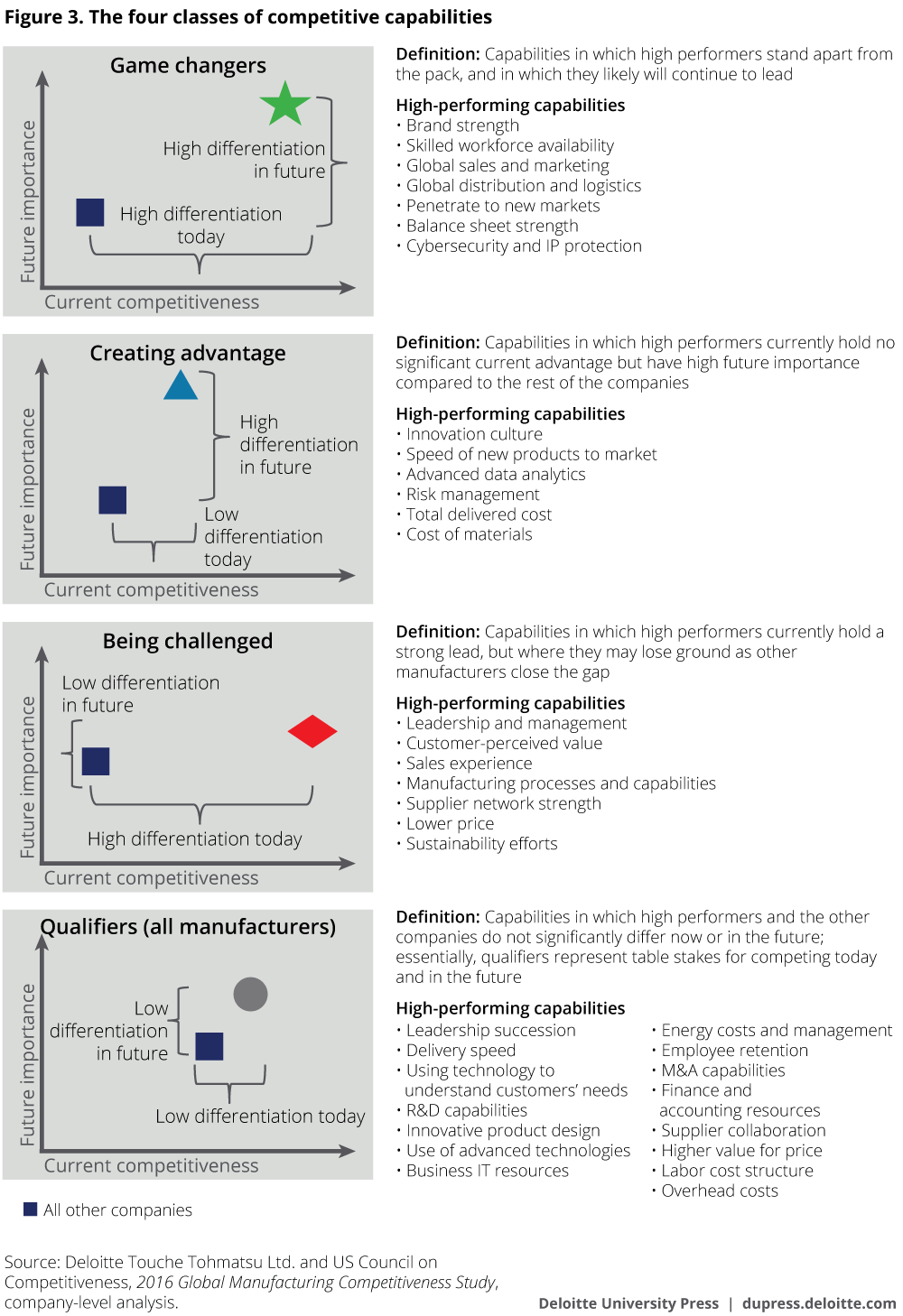
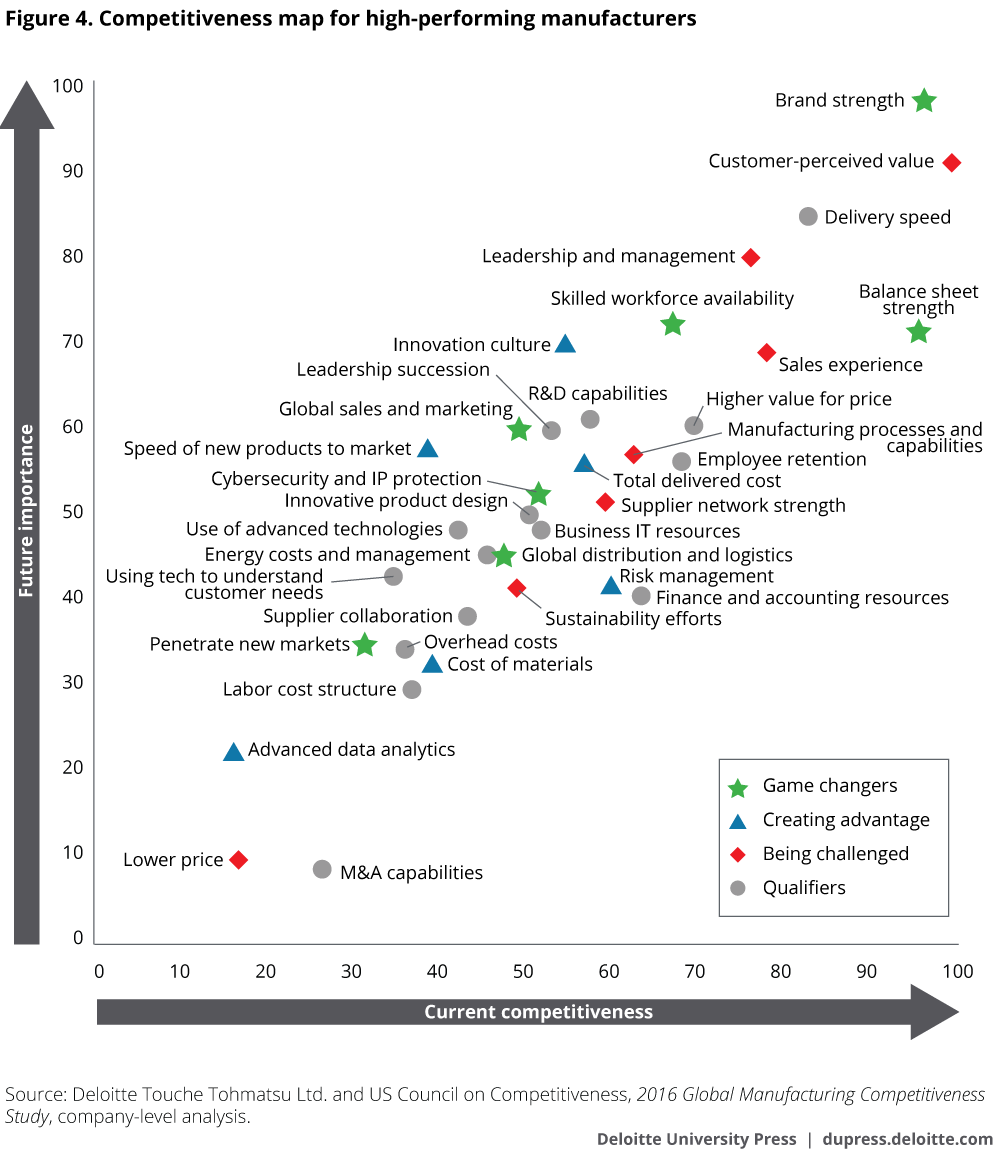
High performers’ strategic focus areas
Nine clusters of capabilities
When we first look at the competitiveness map for high performers (figure 4), the capabilities may appear to be scattered at random. But upon closer inspection, patterns emerge. The 35 individual capabilities align to nine broad clusters of capabilities that help clarify high performers’ high-level focus areas (figure 5). A cluster’s placement relative to both axes reveals how high performers perceive its importance to their competitiveness, today and in the future. Taken as a whole, the clusters of capabilities provide valuable insight into high performers’ capability profile as well as their strategic focus areas.
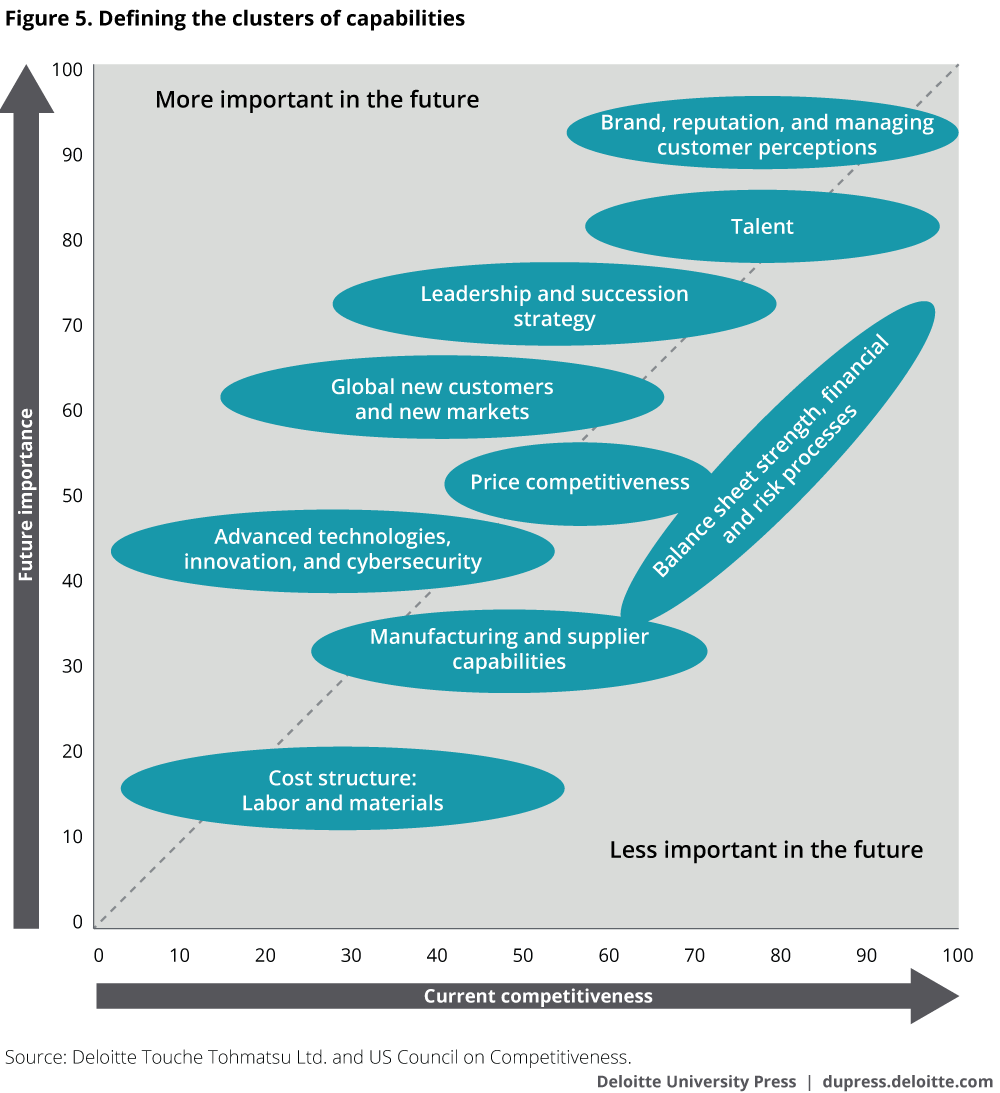
The positioning of the clusters along the two dimensions of current competitiveness and future importance clearly reveals where high-performing manufacturers are placing their priorities. They are focused on being leaders in the areas of brand, reputation, and managing customer perceptions; talent; and leadership and succession strategy. They are also turning to new global markets and customers, improving price competitiveness, and pursuing advanced technologies and innovation for both new products and processes. A deep dive into the makeup of the other clusters reveals additional insights.
From our analysis of high performers’ capability clusters, we have identified the following key takeaways:
Brand, reputation, and managing customer perceptions is high-performing manufacturers’ top priority for current and future competitiveness
High-performing manufacturers rank brand-related capabilities high in current competitiveness and future importance. This cluster of capabilities collectively gravitates toward the upper-right quadrant of the competitiveness map; simply stated, this means that high performers consider these capabilities vital to both their current and future competitiveness.
History has shown the detrimental effects a declining brand and reputation can have on a manufacturer’s bottom line. It is no wonder that brand strength is considered a game changer capability, with high performers placing significantly more emphasis on this capability than other manufacturers both now and in the future. Among the other capabilities within this cluster, delivery speed, customer perceived value, and sales experience also rank high on both axes, with manufacturing executives indicating that these too are capabilities important to both current and future competitiveness.
Looking at the differences between high performers and other companies with respect to these capabilities (figure 4) yields additional insights. With delivery speed classified as a qualifier (that is, a capability on which high performers do not differ from other manufacturers), along with high performers’ being challenged in customer perceived value and sales experience, manufacturing executives are indicating that “the rest” are actively looking to close the gap with high performers in these capabilities.
Given their strategic importance both now and in the future, as well as the narrowing gap between high performers and other manufacturing companies, these brand, reputation, and managing customer expectations capabilities look to play a critical role in the manufacturing competitiveness battlefield ahead.
Talent remains a key capability among high performers, while the gap is closing on leadership capabilities
Many of today’s high-performing manufacturers also consider the talent cluster of capabilities to be strategically important, indicated both by its placement on the scatterplot and the game changer designation of skilled workforce availability. In fact, these findings echo those of another study conducted by Deloitte and the US Council on Competitiveness, which found that manufacturing executives worldwide ranked talent as the most important driver of country-level manufacturing competitiveness.3
Talent will likely be a key competitive lever going forward as the skills gap issue becomes increasingly pervasive. As many as 2 million US manufacturing jobs are likely to go unfilled between 2015 and 2025 due to the unavailability of skilled workers.4 It appears that high performers already recognize the increasing need for a skilled and talented workforce in the face of an evolving manufacturing and technology landscape: High-performing companies plan to continue to differentiate their current and future performance by focusing on this game changer capability. However, concerned with the challenges posed by the skills gap and the difficulty of attracting new, top talent, both high-performing companies and all other manufacturing firms are placing relatively high emphasis on employee retention now and in the future, making it a table-stakes qualifier capability.
With the large wave of Baby Boomer retirements, and the consequent exodus of years of tribal knowledge and leadership, all manufacturers are finding leadership succession increasingly important to their future competitiveness. Strong leadership capabilities can help manufacturing companies effectively push through difficult business decisions, navigate rough waters, and establish marketplace dominance. During tumultuous times, in particular, the importance of strong leadership cannot be overstated. And while high performers currently place greater emphasis on leadership and management than other manufacturers, the gap with regard to its perceived importance for the future is closing.
High performers are focused on improving their price competitiveness while setting their sights on new markets and new customers
Many high performers are clearly interested in pursuing new markets and new customers, as this cluster is home to three game changer capabilities. As manufacturing companies look to benefit from continued globalization, high performers are placing significant emphasis on penetrating new markets and expanding their global sales and marketing capabilities to cater to these new customers and geographies, as well as to hedge against economic downturns or suppressed demand in mature geographies. Rounding out the cluster with yet another game changer capability is global distribution and logistics, a key capability needed to penetrate new markets and spur growth among new customers.
Meanwhile, as high performers continue to penetrate new markets, they are looking to leverage price competitiveness capabilities, creating advantage by focusing on total delivered cost more sharply in the future than their competitors. And while creating higher value for price is a capability on which high-performing manufacturers place strong emphasis, our findings indicate that they will actually find it increasingly difficult to differentiate themselves on this capability. They are therefore apt to look for new ways to create value—in particular, ways involving new technology and innovation.
High performers are aggressively applying new, advanced technologies to help drive innovation while protecting intellectual property through an enhanced emphasis on cybersecurity
Manufacturers continue to seek to set themselves apart and thrive amid global competition by creating a pipeline of differentiated products and services that help capture higher market share and margins. High-performing manufacturers realize that without differentiation through technology or innovation, they are more likely to become cost-driven commodity businesses, making it difficult for them to succeed in the long run. Further, advanced technologies—and the products and services they can enable—hold sizable potential, and they are a core component of many companies’ overall future growth strategy.5
High performers are pursuing differentiation by emphasizing capabilities within the advanced technologies, innovation, and cybersecurity cluster that appear difficult for other companies to duplicate. For example, cybersecurity and intellectual property protection, an innovation culture, advanced data analytics, and speed of new products to market are all game changer or creating advantage capabilities, meaning that high performers have placed or plan to place increased importance on these areas relative to their peers. Meanwhile, R&D capabilities and innovative product design, while critically important to a manufacturer, are increasingly being seen as new table stakes in the manufacturing competitiveness landscape. Advanced technologies and the use of technology to understand customer needs—both capabilities considered to be shift indicators—emerge as areas on which manufacturers are looking to significantly increase their focus in the future.
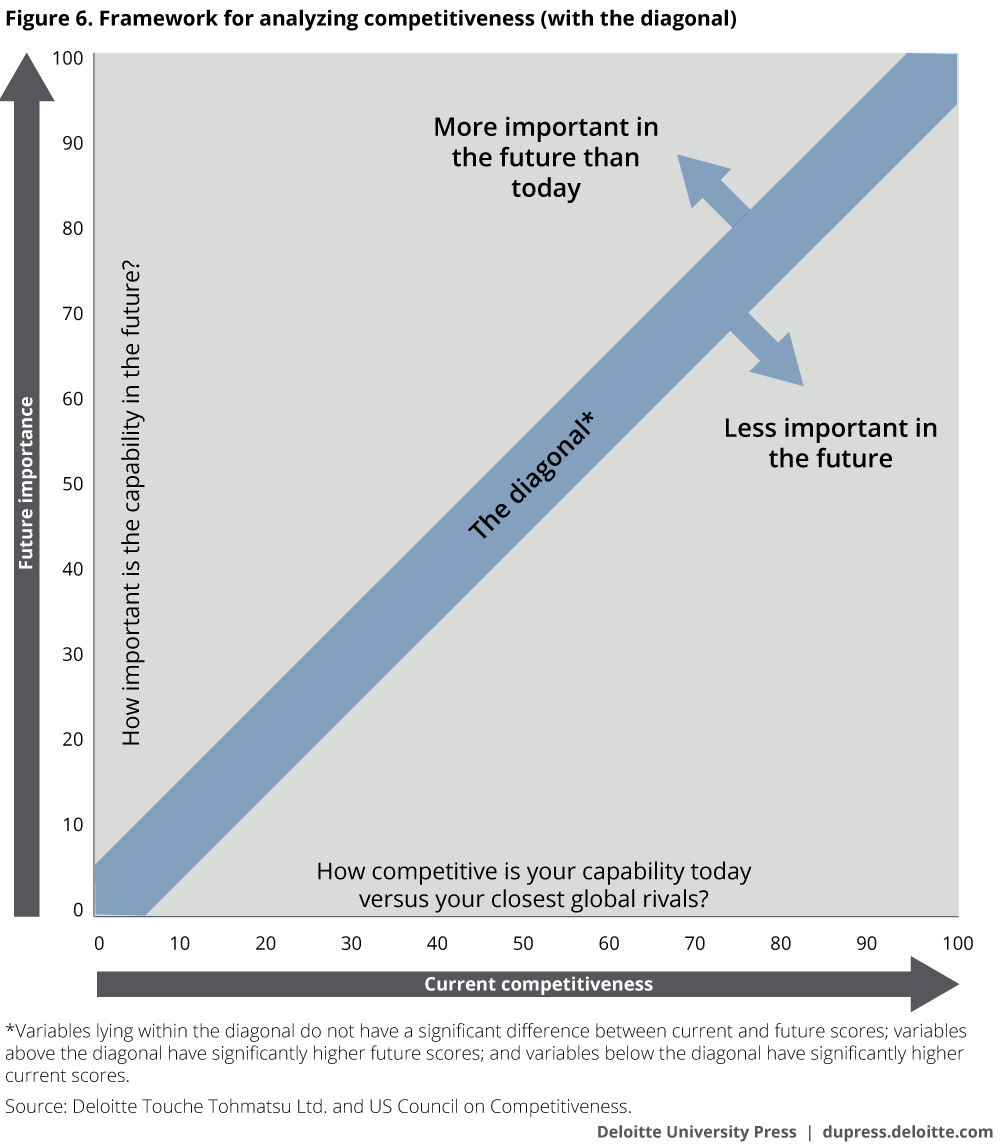
Four classes of differentiating capabilities
While the nine capability clusters depicted in figure 5 define the strategies of high performers along our two dimensions of current competitiveness and future importance, the four classes of differentiating capabilities—described in figure 3 and depicted among high performers in figure 4—help draw out what differentiates high performers’ capabilities from those of other manufacturing organizations. An examination of which capabilities fall into each of these four classes of differentiation helps to answer the following questions:
- Game changers: Which differentiating capabilities are high performers leveraging to create game-changing competitive advantage now and in the future?
- Creating advantage: How are high performers positioning themselves to create new competitive advantage in the future?
- Being challenged: In what areas are other companies catching up with high performers?
- Qualifiers: Are yesterday’s differentiating capabilities still enough to drive high performers’ future success, or have they become table stakes?
High performers both currently outperform their competition and place more importance for the future on game changer capabilities such as creating value through brand strength and using that competitive advantage to penetrate new markets. High performers globalize brands through the use of additional game-changing capabilities such as global sales and marketing and global distribution and logistics capabilities. They build and enable competitive advantage through the use of capabilities related to maintaining a skilled workforce and balance sheet strength. And they have a strong understanding of the need to protect IP and mount strong cybersecurity capabilities to protect their most valuable assets and to continue to differentiate their performance now and in the future.
Bolstering the above game-changing capabilities, high-performing manufacturers indicate that delivering innovative new products to market faster, cultivating a strong innovation culture, and applying advanced analytics to create competitive advantage by generating deeper insights will be areas of future emphasis. Simultaneously, they plan to seek to lower total delivered cost to create a cost and/or pricing advantage over the competition. They are also focusing more strongly than their peers on risk management capabilities to improve their future competitiveness.
High performers face challenges from other manufacturers in capabilities such as sales experience, their product and service bundles’ customer perceived value, and their ability to lower price. In addition, high performers are being challenged as “the rest” look to increase the strength of their supplier network and manufacturing processes while simultaneously stepping up their sustainability efforts. Lastly, other companies are also doubling down and catching up with high performers in critical leadership capabilities as a key way to try to close the gap.
The gap between “the best” and “the rest” is closing: The absolute difference between high performers and other companies in their current competitiveness and future focus has significantly diminished over the past three years. For instance, it is becoming much more difficult for high performers to sustain a competitive edge in back-office areas like finance and accounting resources and business IT resources. Areas such as labor cost structure, overhead costs, and higher value for price have become table stakes as well. However, there are also areas on which most manufacturers—high performers as well as the rest—are placing greater strategic focus in the future, such as R&D capabilities, innovative product design, use of advanced technologies, and using technologies to understand customer needs. That said, the implication remains that, with an increasing number of capabilities becoming table stakes, it is getting harder to differentiate oneself as a high performer.
Identifying shift indicators
As described earlier, shift indicators are capabilities that show a statistically significant deviation from the diagonal of our scatterplot (figure 7). Among the group of high performers, shift indicators are useful for detecting sometimes subtle but important changes in the areas where high performers are placing their bets for the future—or, in some cases, instances where blind spots may be emerging.
Above the diagonal: For individual capabilities, a position significantly above the diagonal on the scatterplot indicates an increase in emphasis on that capability among high performers. As shown in figure 7, high performers are strategically shifting their focus toward capabilities such as speed of new products to market, use of advanced technologies, and using technology to understand customer needs. These capabilities, when woven together, suggest that high performers will be increasingly adopting advanced technologies and data analytics to develop and deliver innovative new products and services to market faster, while allowing them to connect more closely with their global customers in global markets.
Below the diagonal: A position significantly below the diagonal on the scatterplot in figure 7 indicates a decrease in emphasis on that capability among high performers. While our findings indicate that high performers are highly focused on developing new capabilities that can enhance their competitive advantage, like all companies, they can only concentrate on so many capabilities. This leaves a number of qualifier and being challenged capabilities in clusters below the diagonal, hinting that these capabilities may come under future competitive threat. And although manufacturing executives at high-performing companies likely consider many such capabilities to be table stakes for future competitiveness, these capabilities may still provide competitive opportunities for other manufacturers if high performers become complacent. For instance, balance sheet strength, a game changer capability for high performers today, is also a capability on which high performers plan to place significantly less emphasis in the future. Similarly risk management is a creating advantage capability for high performers, but they are placing less importance on it in the future compared to their current competitiveness. Balance sheet strength and risk management may in fact be potential blind spots—areas that high performers may not realize are sources of important strategic advantage and, therefore, on which they are not planning to capitalize as much in the future as they could or should. Granted, our findings indicate that, at this time, the rest of the pack is not focusing on these capabilities to close the gap either. Still, these blind spots may be of some concern, as lower-performing companies could easily sneak up on their higher-performing rivals over time and turn the tables in these areas.
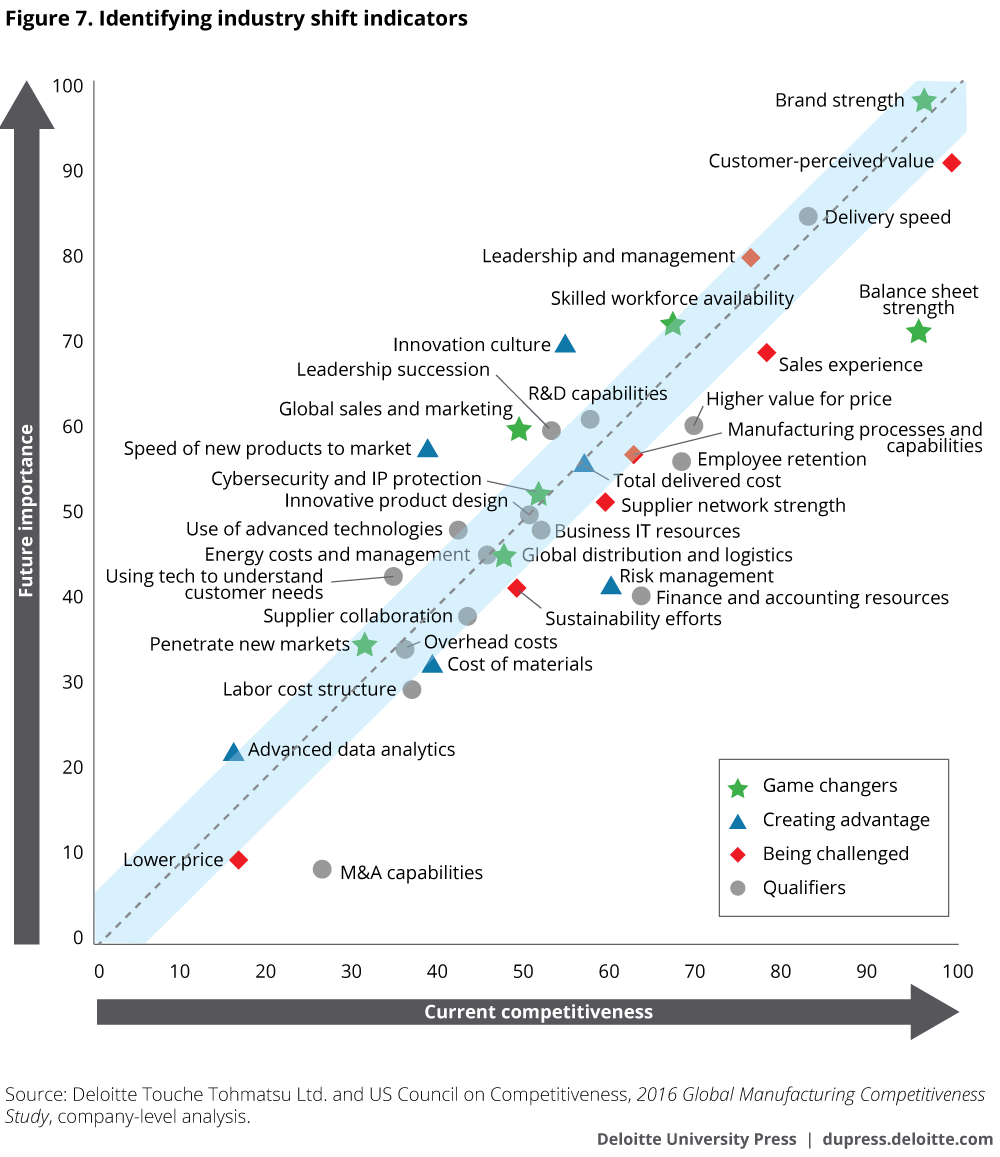
High performers’ advantage is narrowing
When comparing our 2013 and 2016 studies for shifts in capability types or positioning (and the magnitude of those shifts), we found that the difference in capability performance between high performers and other companies has significantly narrowed over the last three years. This indicates that “the rest” have intensified their efforts to close the gap, as reflected by the greater number of qualifiers and the lower number of game changers in this year’s study. This implies that to remain competitive high-performing companies will need to continue to keep their foot on the gas—they should not take their current lead for granted or rest on their laurels. Among the relevant findings:
- Many capabilities have become table stakes in 2016 compared to 2013. The absolute differences between high performers and other companies in their current competitiveness and future focus have significantly diminished from 2013 to 2016. This means that more and more companies are deploying their resources on the capabilities we studied—and that it is becoming much more difficult for high performers to maintain a competitive edge.
- The number of game changer and creating advantage capabilities decreased by nearly 50 percent from 2013 to 2016. For instance, R&D capabilities, delivery speed, supplier collaboration, and innovative product design, all of which were either game changer or creating advantage variables in the 2013 study, are now merely qualifiers. Similarly, manufacturing processes, a game changer in 2013, is a being challenged capability today.
- Brand and talent remain vitally important. Skilled workforce availability coupled with a strong brand reputation help a company produce better products and build a loyal customer base, contributing to higher profitability margins. These two capabilities remained game changers from 2013 to 2016, indicating the consistently important role that talent and brand play in creating a distinctive competitive advantage.
- New clusters of capabilities, such as advanced technologies, innovation, and cybersecurity, are becoming increasingly important for future competitiveness. Three capabilities—use of advanced technologies, use of technology to understand customer needs, and cybersecurity and IP protection—were added in the 2016 study to help clarify the role that advanced technology plays in shaping competitiveness. Cybersecurity and IP protection emerged as a game changer, as high-performing companies think that this capability helps them differentiate their performance both now and in the future. This is not surprising. With more and more manufacturing companies becoming part of a connected ecosystem through smart products, mobile apps, industrial control systems, and ever-growing connected supply networks, it becomes that much more necessary for them to protect themselves from cyberattacks; in addition, advanced manufacturing executives cite IP as their top data protection concern.6 High performers are also looking to increase their focus on advanced data analytics, innovation culture, and speed of new products to market to create competitive advantage in the future. Finally, advanced technologies and use of advanced technologies to understand customer needs were identified as shift indicators, illustrating the importance that both high performers and other companies assign these capabilities for the future. Indeed, the sheer amount and level of focus on advanced technologies by manufacturing executives around the world is quite high: They understand what is at stake and the pace at which the industry is transforming, and they are placing strategic bets in this area as a key battleground in the manufacturing competiveness landscape going forward.
What does this mean for manufacturers?
The bottom line is that manufacturing executives cannot and should not assume that the capabilities that set them apart today will continue to do so in the future. The three-part framework described in this report can help executives analyze their own capabilities and guide them in implementing a relatively simple three-step strategy—assess, align, and act—that can not only better position high performers to continue to excel, but also help “the rest” improve their overall performance and competitiveness.
Assess
Evaluate your company’s capabilities, determine each capability’s position based on current competitiveness and future importance, and assess their relative positioning against that of high performers. This can help answer these important questions:
- What is your company’s winning aspiration? Aspirations are statements about the ideal future. The winning aspiration broadly defines the scope of the company’s activities—“where to play and how to win.” Aspirations can be refined and revised over time but should not change day to day; they exist to consistently align activities within the company.
- Where will your company play? Executives should clearly decide upon the company’s chosen playing field—in which markets, with which customers and consumers, in which channels, and in which product categories and services it will compete.
- How will your company win? How to win is the recipe for success in a company’s chosen playing field.
- What capabilities should be considered to execute? Executives and function/department leaders should identify the capability types and configurations the company will need to win in its chosen segments and chosen way.
- What management systems are required? Executives should determine if the company has the required systems, structures, and measures to enable the selected capabilities and strategic choices.
Align
To align to the company’s aspiration, executives should zoom out and develop a long-term, 10- to 20-year view of the manufacturing industry’s likely evolution. They should then determine the company’s ideal-state capability map and chart the path forward.
- Have strategic focus. Be explicit about aligning resources across specific strategic capabilities which create significant differentiation. Ensure the organization’s configuration, competencies, and incentives reinforce strategic goals as well as attract and motivate top talent.
- Take a portfolio approach and set risk profile strategies accordingly. Balance short-term needs with long-term aspirations and shape strategies, risk profiles, and investments accordingly.
Act
Simultaneously, executives should zoom in to identify the gaps between the current and the ideal positions of their company’s capabilities. Review the 35 individual capabilities examined in this study as well as the clusters above and below the diagonal. Which capabilities does your company have, and on which does it need to place greater emphasis? Develop two to three high-impact initiatives in the next 6 to 12 months to accelerate toward the ideal state in a few focused areas. Remember:
- Anticipate customer needs. Tomorrow’s customers will expect products and services that are increasingly convenient, cost-effective, customized, and connected.
- Operate outside traditional walls. Innovative manufacturers are exploring various mechanisms to connect with the broader ecosystem to meet customer needs and desires at new levels.
- Perseverance pays. Firms with a fear of failure will likely remain followers, behind innovative companies with a greater risk tolerance. There is no single solution or pathway to success.
What’s next for “the best” and “the rest”?
The story of “the best” and “the rest” will continue to unfold in the face of economic, financial, market and technological disruptions. Not only have these disruptions caused a tectonic shift in the competitive landscape, but they have also narrowed the divide between high performers and other companies. Gone are the days when companies could rise with the tide and hide their inefficiencies. High performers today reap the rewards of their superior products and exceptional service in the form of substantial market share and better profitability. However, becoming a high performer is not easy; it requires a keen focus on acquiring needed capabilities—and these change with time. Winning is not an end unto itself but an ongoing process that a company must sustain over many periods to become a true high performer.
© 2021. See Terms of Use for more information.






